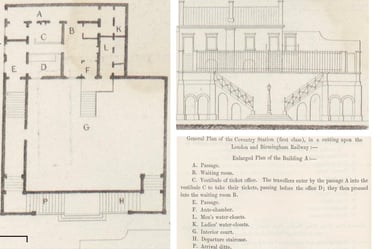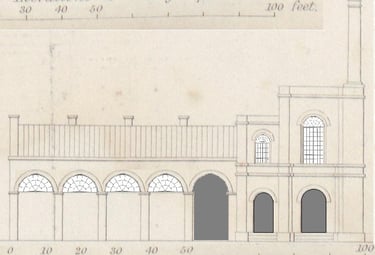I first noticed that there were a set of 'secondary station' drawings in SC Brees (series IV) in 1998. I returned to look at them again in 2019 when revisiting my interest in the London & Birmingham Railway. I realised at the time that in several references to the early London & Birmingham intermediate stations of Watford, Coventry and Tring these plans were absent. It seems that there existence had been forgotten. However back in 1998 I was briefly in touch Ian Forsyth, his 4mm scale model of Watford, was the only correct model I had seen. He must have also been aware that the building currently listed as the original station building was not, his model correctly reflecting the proportions of the Original design. Significantly and Mary Forsyth who had written on the likes of the Henry Henson of the early LNWR, was also an expert on the Railway Cottages. Thus I credit Mary and Ian with being first to acknowledge the significance of these drawings.


Sometime after I noticed a truly excellent website covering some of the history of the London & Birmingham Railway - The Railway Comes to Tring . The website is the work of Gerald Massey and Ian Petticrew. They brought to my attention that although the official architect of the London & Birmingham Railway was Philip Hardwick, it was George Aitchison who was responsible for the design of the intermediate stations.


These are the plans extracted from the SC Brees, also Perdonnet: Fourth series of railway practice : a collection of working plans and practical details of construction in the public works of the most celebrated engineers ... Brees, Samuel Charles, London : John Williams and Co., 1847 'l'Atlas, Portefeuille de Chemin de Fer' [1846] - Auguste Perdonnet, 1801-1867. Contributor: Camille Polonceau 1813-1859. Paris, 1843-46. Language: French


The pumphouse group of buildings was found on a number of early London & Birmingham Stations. At Coventry, Watford and Tring there was also a locomotive engine house - confusingly labelled here as 'shed for carriages' but research shows intermediate stations only received 'carriage sheds' in 1840 onwards. We can be certain that this is an engine shed since it survived until the 1950s, albeit modified. See photos on here on the Warwickshire railways website. There was a need for locomotives to be available along the line for piloting, rescue and impromptu duties, from the opening of the line.
The original image (left) lacks a lot of detail and is essentially only an outline. Another helpful photo from the Warwickshire Railway site helps us to put in the windows. A design repeated along the line on the engine sheds. The doors and windows of the pumphouse and offices are trickier to pin point but here is our suggestion (right)




